We’re all probably pretty conscious about changing our sheets and fluffing our pillows. But when was the last time you gave your mattress some TLC?
It’s easy to forget about mattress cleaning — after all, it’s covered by the sheets, protector, and topper. But dust mites, dead skin, body oils, and other dirt can still accumulate on and inside your mattress (ick).
How to clean a mattress will depend on the type of material. Generally, you should vacuum the mattress surface to remove loose dirt, then follow with an appropriate cleaning solution.
Catch those Zs on a sleep setup that’s fresh, from the sheets all the way down to the mattress. Since you’re spending all night in bed, might as well be clean and comfy!
How Often to Clean | Spot-Cleaning | Before Deep Cleaning | How to Clean | How to Dry | Removing Stains | Mattress Maintenance Tips
Common Types of Mattresses
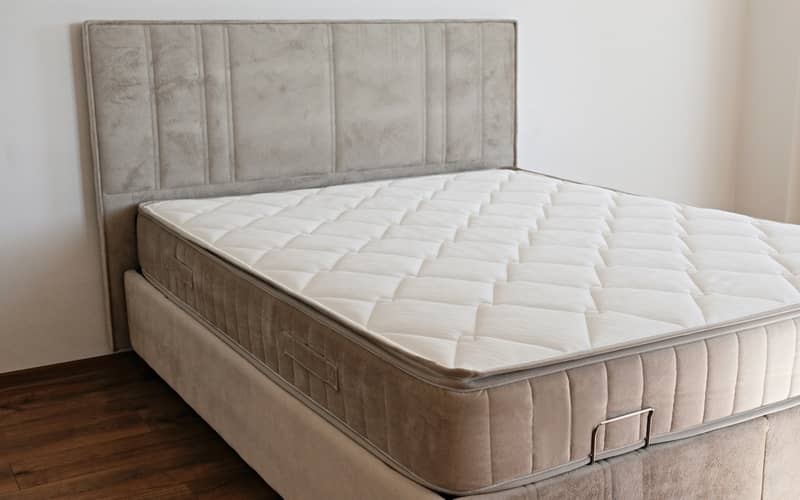
A mattress is your investment for better sleep quality and overall health. There are different types — soft, supportive, bouncy, you name it!
Like Goldilocks, though, you’ll need to find one that’s just right. And after that, you’ll need to learn how to clean it.
AIR MATTRESS: These are great for quick setups — think unexpected guests or backyard camping. Air mattresses are inflatable and lightweight, but not the most comfortable.
FOAM MATTRESS: Foam is a very common mattress material! Unique features mean the cost can vary from affordable, basic mattresses to more expensive, gel-infused ones. Generally, foam is soft but supportive.
HYBRID MATTRESS: As the name suggests, a hybrid mattress combines different materials: springs, foam, or latex. It costs the most upfront, but targets a person’s or couple’s specific sleep needs.
LATEX MATTRESS: Latex is a firm but flexible material, resulting in a mattress that’s comfy while offering great support. These mattresses can be more expensive but are durable and eco-friendly.
SPRING MATTRESS: These mattresses are old-school but reliable, featuring steel coils surrounded by protective material. Also called innerspring mattresses, they come in varying levels of firmness but can wear out faster than other types.
How Should You Clean Your Mattress?
Clean your mattress every 4-6 months (or 2-3 times a year). This keeps it in good condition and prolongs its lifespan.
For people with allergies or pets — or if you’re a sweaty sleeper — bump it up to every 3-4 months.
Wash your mattress protector and mattress topper as well if the timing works out!
Spot-clean a mattress every time you change your bedsheets. For mattresses with a zip-up cover, you can skip this if the cover is too difficult to remove each time.
And, of course, tackle any mattress stains or spills immediately.
How to Spot-Clean a Mattress
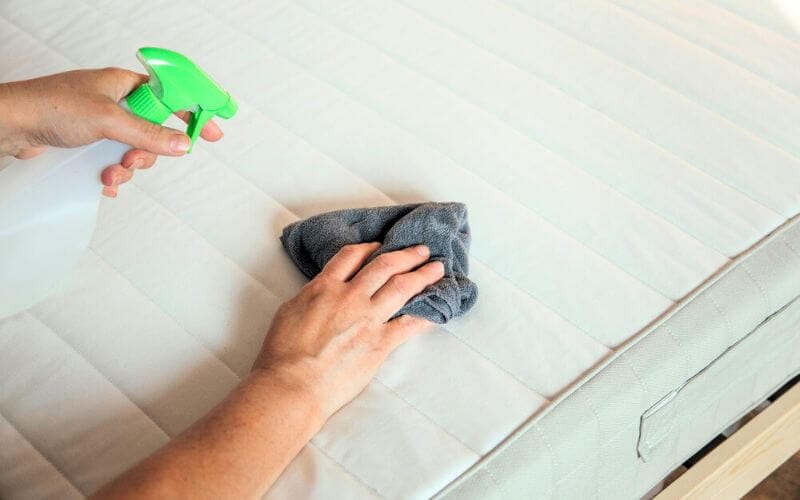
Routine mattress cleaning while changing the sheets is an essential part of bed maintenance!
Spot cleaning can lessen the build-up of bodily fluids, dead skin cells, dirt, and dust mites. It also lets you check for any visible stains or signs of wear.
After you’ve taken off the sheets, set aside the pillows plus the protector or topper if you have them.
Vacuum the entire surface of your mattress. Use your vacuum cleaner’s upholstery attachment or soft brush attachment to minimise the risk of damage.
If there are stains, use the appropriate stain removal method. General cleaning solutions include diluted white vinegar, hydrogen peroxide, or enzyme cleaners.
Quickly disinfect the surface by lightly spraying on 70% rubbing alcohol. Then let your mattress air out for a few hours before putting on fresh sheets.
Before Deep Cleaning a Mattress
Ideally, you should deep clean a mattress at least twice a year. But before you start scrubbing, there are some prep steps to take!
BTW — best to work in the morning, since the cleaning process could take several hours. Otherwise, be ready to sleep in the guest bedroom overnight!
Check the care label on your mattress for any specific instructions or products to avoid.
Strip the bed and wash the bedsheets while you work. Take off any mattress protectors or toppers as well.
Vacuum the mattress surface to remove dust and other debris. Use an upholstery attachment or soft brush attachment, since a roller brush could snag or scuff the material.
Tag in some help to lift the mattress so you can vacuum the underside as well!
Keep all your cleaning supplies handy so you don’t need to go back and forth. Do not use products with harsh chemicals like bleach or ammonia, which can damage the mattress.
Contrary to popular online advice, we do not recommend sprinkling a layer of baking soda then vacuuming it up. Baking soda is very fine and can damage a vacuum cleaner, particularly bagless models or ones without HEPA filters.
It can be safe to vacuum up a small amount of baking soda using a bagged vac or one with a fine HEPA filter. Make sure to clean the vacuum and filter afterwards, especially around the motor.
How to Clean a Dirty Mattress (By Type)
Different types of mattresses have different cleaning methods!
Use the appropriate cleaning solutions to lessen the risk of damaging your mattress (and possibly voiding the warranty).
Take the time to clean your mattress properly — we swear you’ll sleep much better.
Cleaning an air mattress
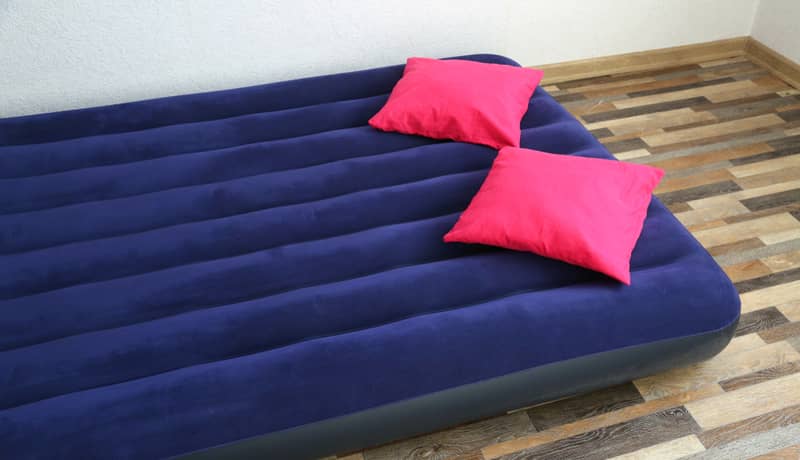
Check if your air mattress manufacturer offers a specialised cleaner, as that’s often your best bet! If not, a homemade solution will work just fine.
Keep your mattress inflated while cleaning to make things easier.
Add a few drops of mild detergent to a large bowl of water and mix thoroughly. Dip a soft cloth into the soapy water, then wring it out
Working one section at a time, use the cloth to carefully scrub the air mattress, including the pump and air vent. For mild stains, rub a bit of detergent into the spot then let it sit for a few minutes.
Afterwards, use a new, clean cloth dampened with fresh water to wipe the mattress clean. Remember to rinse the cloth frequently to remove any soapy residue!
Allow the mattress to air dry in a well-ventilated space.
Cleaning a foam mattress
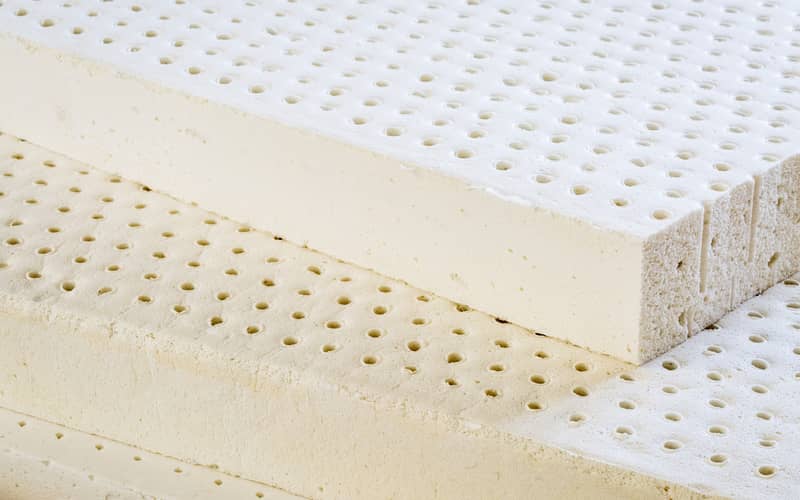
There are several kinds of foam mattresses, such as:
- Latex foam
- Gel-infused foam
- Polyfoam (or polyurethane foam)
- Memory foam (made of viscoelastic)
You can clean most foam mattresses the same way! However, be sure to use as little water as possible when cleaning memory foam or gel-infused foam, as they’re very absorbent.
In a bowl, mix 1 part mild detergent (or dish soap) with 3 parts warm water. Dip a microfibre cloth into the solution, then wring it out so it’s damp.
Carefully wipe the mattress surface clean with the cloth, focusing on any stains and seams.
Alternatively, use a spray bottle, but be careful when you spritz the mattress! It should be just damp, not wet.
Let the cleaning solution sit for up to 45 minutes, then wipe off any residue with a fresh cloth dampened in clean water. Use a dry cloth to gently blot away excess moisture.
NOTE: Steam cleaning is fine for a regular foam mattress if the care label allows it. However, you should not steam clean a memory foam or gel-infused foam mattress.
Cleaning a hybrid mattress
Check the care label or manual of your hybrid mattress — the manufacturer likely has specific cleaning instructions for your mattress design.
In general, use as little liquid as possible when cleaning a hybrid mattress. Spot-clean any stains with a dab of mild detergent or a safe enzyme cleaner.
A mild DIY cleaning solution is a mix of equal parts vinegar and cold water. Do not get the mattress too wet and remove as much moisture as possible before air-drying.
Cleaning a latex mattress
Latex is a durable, water-resistant material, so it’s fairly easy to clean!
Mix equal parts white vinegar and warm water in a spray bottle. Working one section at a time, apply the solution to the latex surface until the entire mattress is damp.
Let it sit for 20 minutes before wiping the latex mattress dry. Repeat on the other sides so the mattress is fully clean.
Set the latex mattress in a well-ventilated room and let it air dry.
NOTE: Keep your latex mattress out of direct sunlight while cleaning! Heat and sun can break down latex and compromise its integrity.
Cleaning a spring mattress
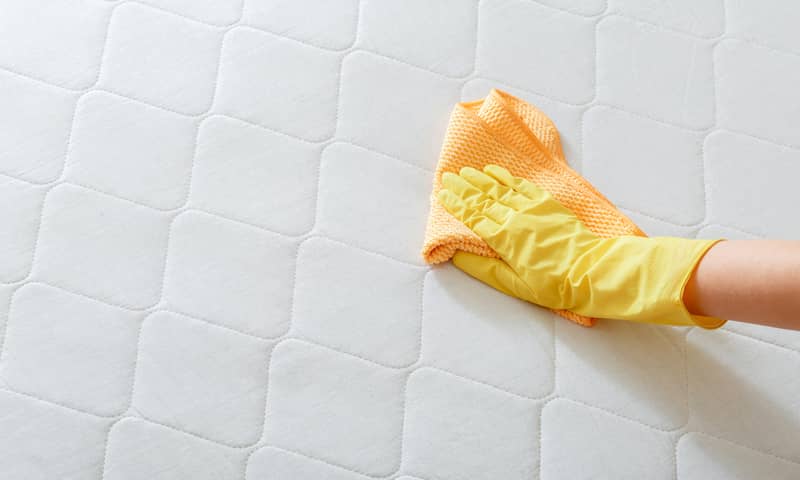
Avoid using a lot of water when cleaning an innerspring mattress, since the moisture can cause the coils to degrade or rust.
Start by mixing equal parts vinegar and cold water in a spray bottle. Lightly dampen the mattress surface, then allow it to evaporate and dry out.
For visible dirt, dip a soft sponge into a mix of water and a few drops of mild detergent. Wring it out, then use it to scrub the dirty mattress surface.
Rinse off the soapy residue with a clean cloth dampened with fresh water, then allow the mattress to air dry.
How to Dry a Mattress
After your regular mattress cleaning, it’s best to let your mattress air dry!
Place the mattress in a well-ventilated space, ideally standing or elevated so that all sides are exposed. Otherwise, flip the mattress every 1-2 hours so it dries evenly.
Keep the mattress out of direct sunlight, which can break down the material (especially latex and foam).
You can speed up the drying process by setting up an electric fan near the mattress. Alternatively, use a blow dryer on the cool setting.
Make sure the mattress is completely dry before returning it to your bed!
How to Remove Stains on a Mattress
When it comes to removing mattress stains, the cleaning method will depend on two things: the type of stain and the type of mattress.
Some mattress materials may be discoloured or damaged by certain products, so check the care label or manual beforehand!
If you’re unsure, test your stain remover on an inconspicuous spot first.
Treating blood stains
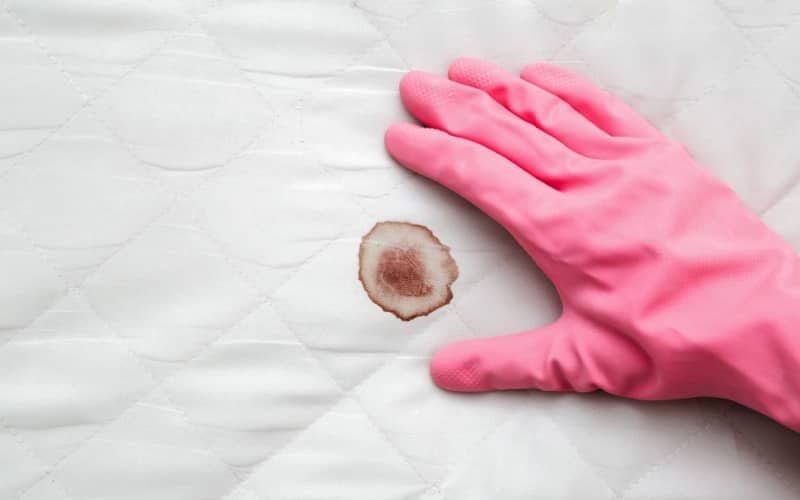
For most non-foam mattresses, remove blood stains with 3% hydrogen peroxide. Apply the solution with a damp sponge, and blot until the stain lifts.
Peroxide may have harmful effects on foam, though, so only use it as a last resort. One alternative solution for removing blood is salt!
Dampen the stained area with some cool water. Avoid using hot water as this can “cook” the stain into the mattress.
Sprinkle a generous layer of salt onto the stain and let it sit for up to 30 minutes. Vacuum up the residue, then dab the spot clean with a damp cloth.
For stubborn stains, try a safe enzyme cleaner.
Treating sweat stains
Sweat and body oils can seep through bedding and stain your mattress underneath.
Mix equal parts white vinegar and cold water in a spray bottle. Lightly spray the yellow stains and let the solution sit for up to an hour.
Blot any excess moisture with a clean cloth, then leave the mattress to air out and dry.
Treating urine stains
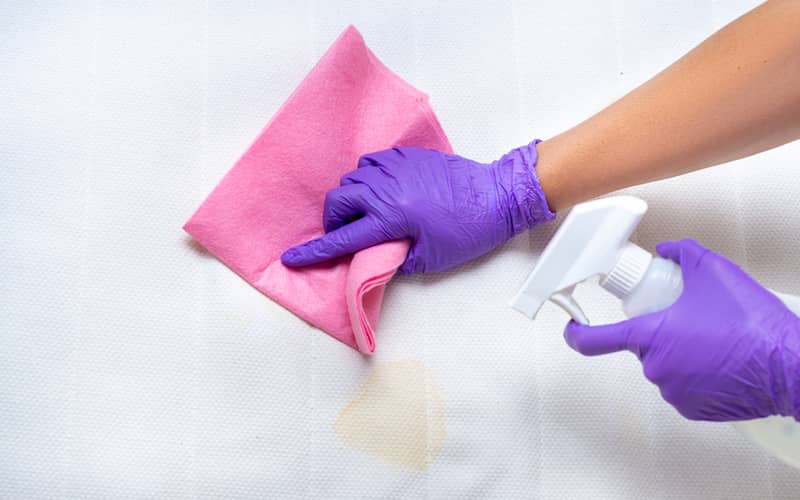
Whether someone had an accident in bed or your pet couldn’t wait to go outside, get urine stains out ASAP. This prevents the odour from setting into the mattress (gross, we know).
Dampen a soft cloth with cold water, then dab the stained area. This will help dilute and absorb the urine.
Mix up a white vinegar solution in a spray bottle and apply it to the stain. Wait 20 minutes before patting the spot dry with a clean cloth.
Repeat until all the urine has been removed. Afterwards, allow the mattress to air dry in a well-ventilated room so the vinegar scent dissipates.
If the stain is small, you can neutralise any remaining odours and moisture with a few tablespoons of baking soda. Wait a few hours, then use a soft-bristled brush to “sweep” off the baking soda into a rubbish bin.
Treating vomit stains
Put on a pair of rubber gloves and remove any solids from the mattress. Use some paper towels or old rags to absorb excess moisture.
Treat the vomit stain with a safe enzyme-based cleaner. These are formulated to tackle biological stains — just ensure the product is compatible with your mattress type!
Follow the product instructions and wash the mattress afterwards.
Essential Mattress Maintenance
Change and wash your bedsheets regularly — ideally every 1-2 weeks. Clean sheets keep things fresh and minimise the moisture around the mattress surfaces.
It also works the other way! A clean mattress means less dirt getting on your linens.
Let your mattress air out for a few hours before putting on new sheets. This prevents musty odours and deters the growth of bacteria, mould, or mildew.
Use a mattress protector to minimise the dirt that comes in contact with your mattress. A waterproof mattress protector also helps block stains from drinks and bodily fluids.
Replace your mattress when it’s worn out or damaged. A good quality mattress should last you up to 10 years, though some types (like innerspring) wear out more quickly.
Finally, make sure the rest of your bedroom is clean, too. A dirty bedroom causes your bed (and mattress) to accumulate dust, pet hair, and other dirt more easily.
If keeping a regular cleaning schedule feels overwhelming, tag in a professional home cleaner to help!
FAQs About Cleaning Mattresses
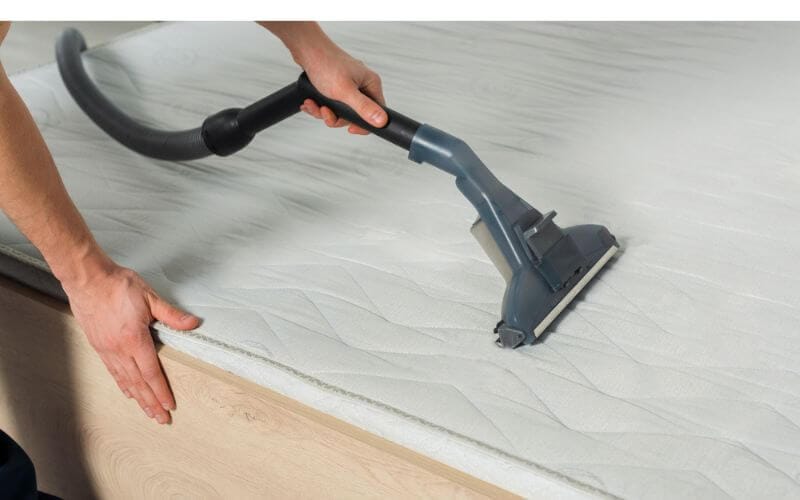
Here are a few more tips and things to know about mattress cleaning.
How do you deep clean a mattress without a machine?
If you don’t have a vacuum upholstery attachment or a steam cleaner, you can still deep clean a mattress!
Use a duster or similar soft cleaning brush to remove dust and debris from the mattress surface. Don’t forget to sweep the floor afterwards.
Follow the rest of the steps for cleaning your mattress.
Does baking soda really clean a mattress?
Baking soda does not directly clean stains or dirt from a mattress. However, it can help neutralise odours and absorb lingering moisture.
However, you should not vacuum up baking soda on a mattress, as this can damage the vacuum cleaner. If it’s necessary, use a small amount (such as for a small stain) and use a bagged vac or one with a HEPA filter.
Can I hose down my mattress?
No, you should not hose down your mattress! This introduces too much moisture, which gets deep into the mattress and may not fully dry out.
Any moisture trapped in your mattress can lead to mould and bacteria.
Do I need to flip my mattress after cleaning?
You can rotate your mattress after cleaning, but there’s no need to flip it!
Depending on the type of mattress, it may have special layers designed for specific functions. Flipping your mattress puts those layers out of order and makes things uncomfortable.
Rotating a mattress, on the other hand, allows an even distribution of pressure and wear-and-tear. Rotate your mattress (and topper!) every 3-6 months.
The only exception would be hybrid mattresses designed with different materials on each side of the mattress.

